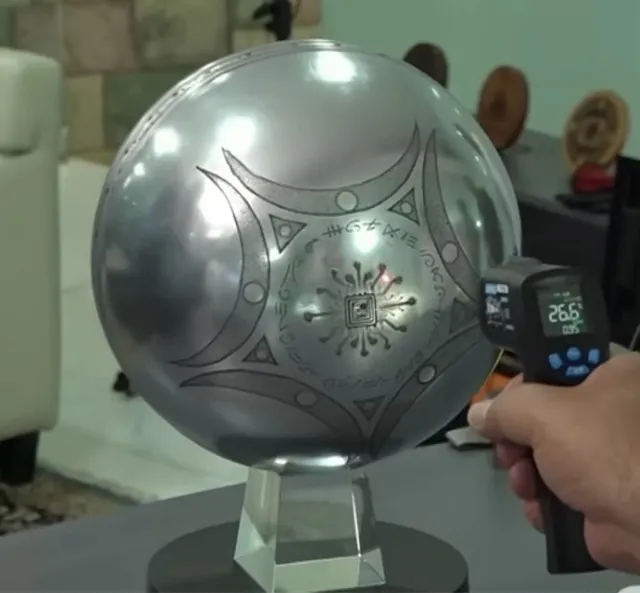
In early 2025, a shiny metallic ball crashed onto a farm in Buga, Colombia. People called it the Buga Sphere. At first, it sparked wild stories about alien tech from ancient times. But dig deeper, and you see cracks everywhere. This thing isn’t a mystery from the stars. Instead, it’s a rough hoax designed to fool eager believers. Accordingly, let’s peel back the layers and expose why the Buga Sphere stands as a prime example of a crude scam in the world of UFO claims.
The buzz started in March 2025 when locals found the sphere. Videos showed it looking seamless, with strange markings etched on its surface. Soon, figures like Dr. Steven Greer jumped in, claiming it held secrets from 12,560 years ago. They said tests proved it came from non-human intelligence. However, as more details emerged, skeptics pointed out flaws. Not only did the story rely on shaky evidence, but it also echoed old tricks used in past hoaxes. Basically, the Buga Sphere promised wonders but delivered deceit.
What Exactly Is the Buga Sphere?
Farmers in Colombia spotted the object first. It measured about the size of a basketball, made from what looked like metal layers. X-rays supposedly revealed inner parts, including tiny spheres and wire-like structures. Promoters described it as advanced tech, far beyond what humans could build back then—or even now in some cases.
Dr. Greer, a known UFO advocate, released a report on October 17, 2025. He stated carbon-14 dating from the University of Georgia pegged it at over 12,000 years old. The alloy included rare earth elements, unknown to science until the 1800s. Fiber optics wove into its shell, hinting at 3D printing from another world. Two experts even translated the symbols as proto-Sanskrit warnings about cosmic events.
Yet, these claims crumbled under scrutiny. The dating applied to resin on the sphere, not the metal itself. Organic material like that easily picks up contaminants, skewing results. Critics noted the report’s errors and manipulations. In addition, videos showed the sphere “reacting” to Sanskrit chants, but many called this staged. All in all, the Buga Sphere seemed more like a prop than a probe.
The Wild Claims Surrounding It
Promoters didn’t stop at age and materials. They said the sphere changed weight—from 2kg to 10kg—without reason. It emitted radio signals and stayed cool under heat. Some videos claimed it moved on its own, defying gravity. Greer linked it to magnetic anomalies in South America, suggesting it warned of disasters.
Furthermore, stories spread about multiple spheres in the area. Only one got recovered, but videos of others flying around fueled the hype. Researchers using quantum AI supposedly “cracked” its code, finding godlike secrets inside. Bashar, a channeled entity, even commented on it during a conference.
However, these tales lacked solid proof. No independent labs confirmed the weight shifts or signals outside controlled settings. Videos often came from biased sources, raising red flags. For instance, one clip showed it “opening” with human touch, but experts saw signs of editing. Despite the excitement, the claims felt too perfect, like a script from a sci-fi flick.
Unmasking the Evidence of Fraud
Skeptics dug in and found holes. First, the metallurgy. Labs called it an aluminum alloy, but compositions matched everyday materials with tweaks. The “fiber optics” resembled standard cables, possibly from a garage build. No welds? Modern casting can achieve that without alien help.
Then, the dating fiasco. Carbon-14 works on organic stuff, not metal. The resin sample could have migrated through cracks, messing up ages. The report was a single page with mistakes, screaming amateur hour.
Moreover, online sleuths traced it to viral marketing. One post revealed it as a hoax by a shady company pushing scams. Reddit threads labeled it fraud, with optical illusions inside. Even NASA got dragged in, but no real ties existed. In short, the Buga Sphere failed basic tests of authenticity.
The Players Behind the Curtain
Jaime Maussan and Steven Greer led the charge. Maussan, a Mexican journalist, has a history of promoting fakes, like mummified “aliens” debunked as dolls. Greer runs the Disclosure Project, pushing for UFO reveals, but critics say he mixes facts with fiction for gain.
Their involvement raised alarms. Greer hypothesized the sphere as Atlantean tech activated now. But posts called it “bogus,” with videos showing poor craftsmanship. One expert said it mimicked NASA’s propulsion models, not ET designs. Basically, these figures amplified the scam for attention.
Not to mention, social media fueled it. X posts hyped it as real, but others debunked it months ago. A user noted it as “certified fabrication.” The mix of promotion and exposure showed how scams spread online.
Why Call It a Crude Scam?
What makes the Buga Sphere “crude”? Its flaws shine through. Unlike slick hoaxes with pro effects, this one used obvious tricks. The etchings looked hand-done, not laser-precise. Videos had glitches, and claims contradicted science basics, like misusing carbon dating.
Additionally, it preyed on hopes for disclosure. People want proof of aliens, so they overlook red flags. But as one physicist warned, extraordinary claims need ironclad evidence. Here, it fell short, making the deception sloppy.
Compared to past scams, like Roswell debris, this felt rushed. No peer-reviewed papers backed it, just press releases. In essence, the Buga Sphere exposed itself through poor execution.
The Broader Impact on UFO Research
This hoax hurts real inquiry. Serious scientists study UAPs, but fakes like the Buga Sphere muddy waters. They make skeptics dismiss everything, slowing progress.
For example, recent papers on transients linked to UFOs got attention. But tying them to scams erodes trust. Communities on Reddit and X debate fiercely, splitting believers.
Nevertheless, it teaches lessons. Demand evidence, question sources, and avoid hype. As one post said, push for proof, not disclosure alone. That way, real breakthroughs shine.
Lessons for the Future
Scams like the Buga Sphere remind us to stay vigilant. Tech advances make fakes easier, but critical thinking spots them. Share facts, not fiction, to build knowledge.
In the end, while some cling to mystery, truth wins. The Buga Sphere isn’t ancient tech—it’s modern mischief.
To wrap up, this case shows how easily deception spreads in our connected world. Ultimately, we must question bold claims and seek solid proof. As we move forward, let’s prioritize real science over sensational stories. The importance of this matter cannot be overstated. What will the future hold if we ignore the signs? Only through collective effort can we separate fact from fraud.

Leave a Reply